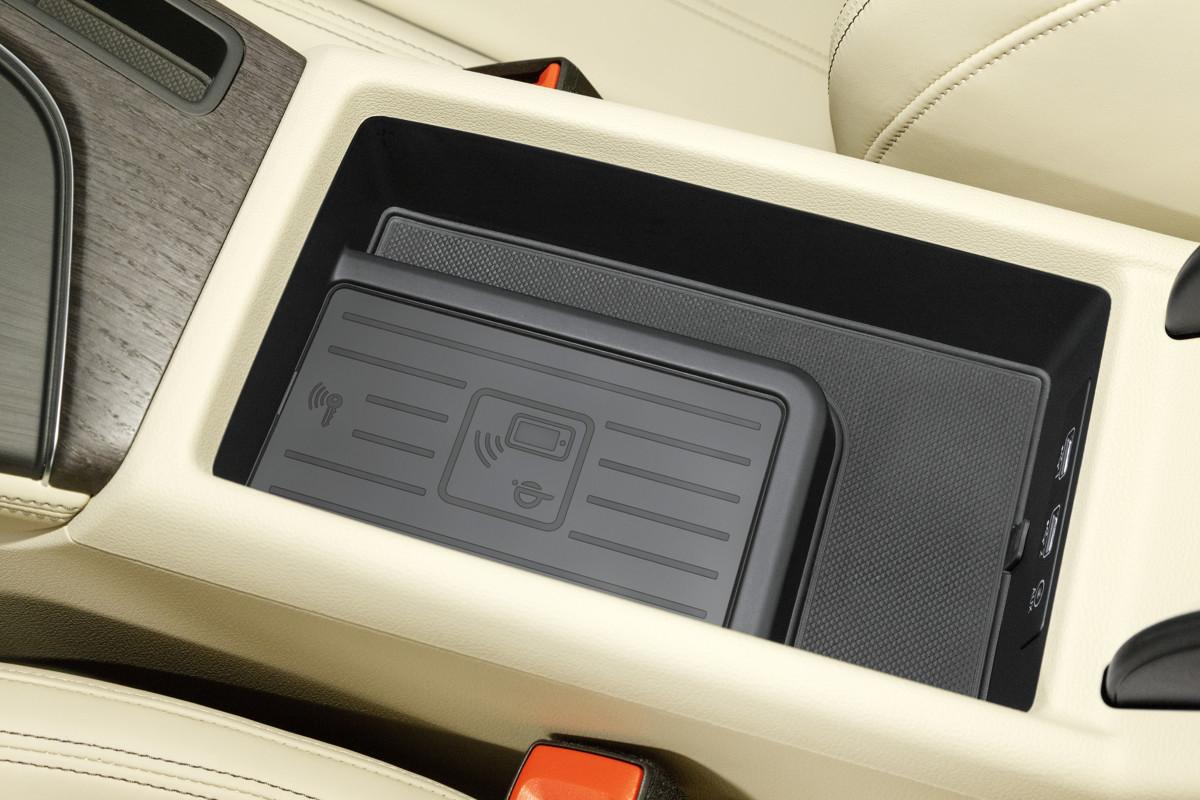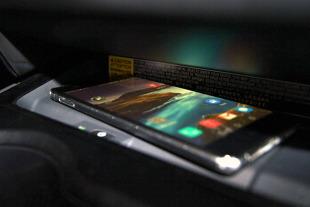
Induction car charger. A bit of elementary school magic
Content
 Physics is not a favorite subject in school for many students. It's a pity, because in everyday life it can be seen at every step. Only that for some such a problem will be “the magic of XNUMXth century technology”, and for others it will be the technological use of physical phenomena. Such is the case with inductive phone charging.
Physics is not a favorite subject in school for many students. It's a pity, because in everyday life it can be seen at every step. Only that for some such a problem will be “the magic of XNUMXth century technology”, and for others it will be the technological use of physical phenomena. Such is the case with inductive phone charging.
Inductive charger. Some memories from school
Probably everyone remembers such an experience in a physics lesson, when a magnet was moved inside a coil connected to a sensor. As long as the magnesium was not stationary, there was no current. But when the magnet moved, the gauge needle vibrated. It was similar in the case of metal filings on a coil connected to electricity.
 If there was no current flow, sawdust lay next to it. However, when a current flowed through the coil, the filings were immediately attracted to the magnet. This is the phenomenon of electromagnetic force generation caused by a change in magnetic flux. This phenomenon was discovered by the English physicist Michael Faraday in 1831, and now - nearly 200 years later - it is becoming standard in our homes and cars when charging our phones.
If there was no current flow, sawdust lay next to it. However, when a current flowed through the coil, the filings were immediately attracted to the magnet. This is the phenomenon of electromagnetic force generation caused by a change in magnetic flux. This phenomenon was discovered by the English physicist Michael Faraday in 1831, and now - nearly 200 years later - it is becoming standard in our homes and cars when charging our phones.
According to the experience of an elementary school, two elements are needed for wireless charging - a transmitter and a receiver, in which coils are placed. When current flows through the transmitter coil, an alternating magnetic field is created and an electromagnetic force is generated (option with sawdust). It is picked up by the receiver coil and ... current flows through it (an option for moving the magnet next to the coil). In our case, the transmitter is the mat on which the phone lies, and the receiver is the device itself.
However, for trouble-free wireless charging, the charger and phone must comply with the relevant standards. This standard is Qi [Chi], which in Chinese means “energy flow”, that is, simply inductive charging. Although this standard was developed in 2009, more and more advanced technologies are making devices more and more accurate. We must remember that both devices (transmitter and receiver) do not have direct contact with each other, and thus part of the energy is dissipated during transportation. Therefore, an important issue is that as little energy as possible is wasted.
What to look for when choosing an inductive charger?
Inductive charger. Compatibility
In addition to universal chargers, special chargers are also used. When choosing a model, you should pay attention to whether it will work with our phone.
Inductive charger. Charging current
 An important issue is the charging current. As mentioned earlier, the devices do not come into direct contact with each other, and thus some of the energy is dissipated during transport. Therefore, the strength of the charging current depends, among other things, on the download speed. Good induction chargers have a voltage and current of 9V / 1,8A.
An important issue is the charging current. As mentioned earlier, the devices do not come into direct contact with each other, and thus some of the energy is dissipated during transport. Therefore, the strength of the charging current depends, among other things, on the download speed. Good induction chargers have a voltage and current of 9V / 1,8A.
Inductive charger. Charging indicator
Some chargers have LEDs that show the charge status of the phone's battery. The different battery levels are then displayed in a different color.
Inductive charger. Mount type
In this case, there is a chance to buy a pad similar to those used in the office or at home, or a classic car holder.
 Unfortunately, if we decide on a spacer, we must know that not every car has a place to install it. Usually in SUVs or vans we have a fairly large compartment on the console between the seats in front of the dashboard, but in most cars this can be a problem.
Unfortunately, if we decide on a spacer, we must know that not every car has a place to install it. Usually in SUVs or vans we have a fairly large compartment on the console between the seats in front of the dashboard, but in most cars this can be a problem.
In this case, the only way out of the situation is a classic car mount. They are attached to the windshield, upholstery or ventilation grilles.
As I read on the site of one online store:
“Inductive chargers provide incredible convenience during use. No more messing with cables, breaking plugs, losing equipment and finding it in the most unexpected places! You only need to put your phone on the special stand to start charging.”
Unfortunately, my opinion is slightly different. The phone is charged in the car only during long trips (8-9 hours non-stop) and listening to files stored in memory. Each time the phone is placed in the glove compartment and I have never lost it in the car. What's more, the charger cable never makes me tangled up in cables, which is not the case with a cable connected to a "special stand" located on the windshield or dashboard and powered by a cable from a car USB outlet or 12V. .
So the purchase of an external induction charger in a car that is used by the average person, I consider it an overrated gadget. The situation is different with couriers, sales representatives or professional drivers who have to travel a lot and often use the phone. In this case, placing the phone on a stand, especially when we have a speakerphone, helps a lot.
The cost of such a stand with an induction charger ranges from PLN 100 to PLN 250 and depends on the quality of the device (output current), as well as ergonomics and aesthetics (type of materials, method of holding the phone with a clip or magnet).
 Searching the Internet, I found another type of chargers that I can recommend to everyone. These are interchangeable elements in the car console. It is enough to remove the shelf in the center console of the car and put in this place a kit in which the shelf is an induction charger connected inside the console to the installation. As a result, we have no cables or protruding handles, and the induction charger is mounted in the car, as in the factory versions. The cost of such a set is about 300-350 zł.
Searching the Internet, I found another type of chargers that I can recommend to everyone. These are interchangeable elements in the car console. It is enough to remove the shelf in the center console of the car and put in this place a kit in which the shelf is an induction charger connected inside the console to the installation. As a result, we have no cables or protruding handles, and the induction charger is mounted in the car, as in the factory versions. The cost of such a set is about 300-350 zł.
Another important thing to remember is that every phone has inductive charging. If our phone does not have wireless charging capability, we can buy special cases or covers that must be attached to the "back" of our phone and connected to the charging socket. As a result, the overlay (case) is the missing element that receives energy, and through the charging socket, the current feeds our phone. Such an overlay costs in the basket from 50 to 100 zł, depending on the phone model and the manufacturer of the overlay.
Inductive charger. Factory charger in new model
As these chargers became very popular, they were offered as a factory option on new vehicles. Of course, initially these were only options in the Premium classes, but now you can venture to say that they "hit the ass" and are generally available.
For example, in the Mercedes C Cabrio in the Standard version, the option "Wireless phone and charging via Bluetooth" costs PLN 1047. In the Audi A4, the "Audi phone booth" option costs PLN 1700, while in the Skala Scala, the "bluetooth plus" option, which includes connection to an external antenna - a wireless charger for a smartphone, costs PLN 1250.
Inductive charger. Is it worth it?
Whether it is worth spending more than 1000 PLN on a new car, everyone must judge for himself. When it comes to buying a setup for around PLN 100-200 for a used old model, I sincerely advise against it. Please analyze how long your battery lasts after overnight charging? Can I top up my phone at work? Is it worth it to buy a holder for a one-time use of a charger and spoil the decor of the dashboard? Only an analysis of these questions will answer whether it is really worth ...
Read also: Testing Volkswagen Polo

